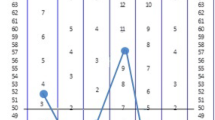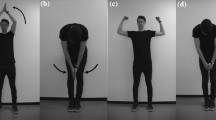Abstract
Objective
The relative length of the second and fourth digits (2D:4D) has been proposed as a marker of the prenatal androgen effects, with a relatively longer fourth finger indicating higher prenatal androgen exposure. Low 2D:4D has been reported to correlate with high performance and mood states in sport in general. On the psychological side, tests able to measure specific psychological features and mood states have been used. Here, we examined the relationship between 2D:4D and mood states in elite female water polo players.
Method
We administered the Profile of Mood States (POMS) questioner in 15 players at the beginning (October) and at the end of the competition season (December), as well as 3 months after its end (March).
Results
We observed a positive relation only between 2D:4D ratio and anger. This relation was significant in October (r = 0.756, P < 0.01) and March (r = 0.733, P < 0.01), whereas the significance was not detected in December.


Similar content being viewed by others
References
McIntyre MH, Ellison PT, Lieberman DE, Demerath E, Towne B (2005) The development of sex differences in digital formula from infancy in the Fels longitudinal study. Proc R Soc 272:1473–1479
Trivers R, Manning JT, Jacobson A (2006) A longitudinal study of digit ratio (2D:4D) and other finger ratios in Jamaican children. Horm Behav 49:150–156
Manning JT, Scutt D, Wilson J, Lewis-Jones DI (1998) The ratio of 2nd to 4th digit length: a predictor of sperm numbers and levels of testosterone, LH and oestrogen. Hum Reprod 13:3000–3003
Coates JM, Gurnell M, Rustichini A (2009) Second-to-fourth digit ratio predicts success among high-frequency financial traders. Proc Natl Acad Sci USA 106:623–628
Coco M, Perciavalle V, Maci T, Nicoletti F, Di Corrado D, Perciavalle V (2011) The second-to-fourth digit ratio correlates with the rate of academic performance in medical school students. Mol Med Report 4:471–476. doi:10.3892/mmr.2011.456
Tester N, Campbell A (2007) Sporting achievement: what is the contribution of digit ratio? J Pers 75:663–677
Manning J (2002) The ratio of 2nd to 4th digit length and performance in skiing. J Sports Med Phys Fitness 42:446–450
Manning J, Taylor R (2001) Second to fourth digit ratio and male ability in sport: implications for sexual selection in humans. Evol Hum Behav 22:61–69
Hellhammer DH, Hellhammer J (2008) Neurobehavioral medicine and stress-related disorders. In: Hellhammer J, Hellhammer DH (eds) Stress: the mind–body connection. Karger, Basel, pp 1–10
Tenenbaum G, Jones CM, Kitsantas A, Sacks DN, Berwick JP (2003) Failure adaptation: psychological conceptualization of the stress response process in sport. Int J Sport Psychol 34:1–26
McNair DM, Lorr M, Droppleman LF (1971) Profile of mood states manual. Education and Industrial Testing Service, San Diego
Morgan WP (1974) Selected psychological considerations in sport. Res Q Exerc Sport 45:374–390
Morgan WP, Pollock ML (1977) Psychological characterization of the elite distance runner. Ann NY Acad Sci 301:383–403
Koutedakis Y, Budgett R, Faulmann L (1990) Rest in underperforming elite competitors. Brit J Sport Med 24:248–252
Morgan WP (1980) The trait psychology controversy. Res Q Exerc Sport 51:50–76
Morgan WP (1985) Selected psychological factors limiting performance: a mental health model. In: Clarke DH, Eckeri HM (eds) Limits of human performance. Human Kinetics, Champaign, pp 70–80
Voracek M, Bagdonas A, Dressler SG (2007) Digit ratio (2D:4D) in Lithuania once and now: testing for sex differences, relations with eye and hair color, and a possible secular change. Coll Antropol 31:863–868
Coates J, Hebert J (2008) Endogenous steroids and financial risk taking on a London trading floor. Proc Natl Acad Sci USA 105:6167–6172
Ashbaugh D (1999) The identification process. In quantitative-qualitative friction ridge analysis: an introduction to basic and advanced ridgeology. CRC Press, Boca Raton, p 234
Kimura S, Schaumann B, Plato C, Kitagawa T (1990) Embryological development and prevalence of digital flexion creases. Anat Rec 226:249–257
Manning JT, Reimers S, Baron-Cohen S, Wheelwright S, Fink B (2010) Sexually dimorphic traits (digit ratio, body height, systemizing–empathizing scores) and gender segregation between occupations: evidence from the BBC internet study. Pers Indiv Differ 49:511–515
Hanin YL (2004) Emotions in sport: an individualized approach. In: Spielberger CD (ed) Encyclopedia of applied psychology. Elsevier Academic Press, Oxford, pp 739–750
Othmer E, Othmer SC, Othmer JP (2005) Diagnosis and psychiatry examination of the psychiatric patient. In: Sadock BJ, Sadock VA (eds) Kaplan and Sadock’s comprehensive textbook of psychiatry. Lippincott Williams & Wilkins, Philadelphia, pp 795–826
Wann DL (2005) Essay: aggression in sport. Lancet 366:31–32
Spielberger CD (1991) Manual for the state-trait anger inventory (STAXI). Psychological Assessment Resources, Odessa
Jones MV (2003) Controlling emotions in sport. Sport Psychol 17:471–486
Hanton S, Connaughton D (2002) Perceived control of anxiety and its relationship to self-confidence and performance. Res Q Exerc Sport 73:87–97
Hanton S, Mellalieu SD, Hall R (2004) Self-confidence and anxiety interpretation: a qualitative investigation. Psychol Sport Exerc 5:477–495
Beedie CJ, Terry PC, Lane AM (2000) The profile of mood states and athletic performance: two meta analyses. J Appl Sport Psychol 12:49–68
Robazza C, Bortoli L (2007) Perceived impact of anger and anxiety on sporting performance in rugby players. Psychol Sport Exerc 8:875–896
Pellitteri J (2002) The relationship between emotional intelligence and ego defense mechanisms. J Psychol 136:182–194
Conflicts of interest
There are no conflicts of interest for any of the authors.
Author information
Authors and Affiliations
Corresponding author
Rights and permissions
About this article
Cite this article
Di Corrado, D., Perciavalle, V. Digit ratio (2D:4D) and mood states in elite female water polo players. Sport Sci Health 9, 19–23 (2013). https://doi.org/10.1007/s11332-013-0140-2
Received:
Accepted:
Published:
Issue Date:
DOI: https://doi.org/10.1007/s11332-013-0140-2




